The giant anteater is an iconic creature of South America but it’s listed as vulnerable to extinction. The scrub forests and grasslands within the Cerrado biome of Brazil are under threat and, in the last 35 years, more than half of Brazil’s Cerrado has been converted into pasture or agricultural lands for cash crops. The remaining habitat is highly fragmented and bisected in several places by an extensive road network. These roads worsen the habitat fragmentation and are a severe cause of mortality for local animals. In the Mato Grosso do Sul in particular, giant anteaters suffer some of the highest number of fatalities. We are currently funding Arnaud Desbiez and his team to understand the impact and effect of roads on giant anteater populations in the scrub forests and grasslands within the Cerrado biome of Brazil. Arnaud will take the results from the project and translate them into landscape and road management guidelines to mitigate the negative effects roads are having on wildlife. He has written to us to update us on the progress of project.
Anteaters and highways
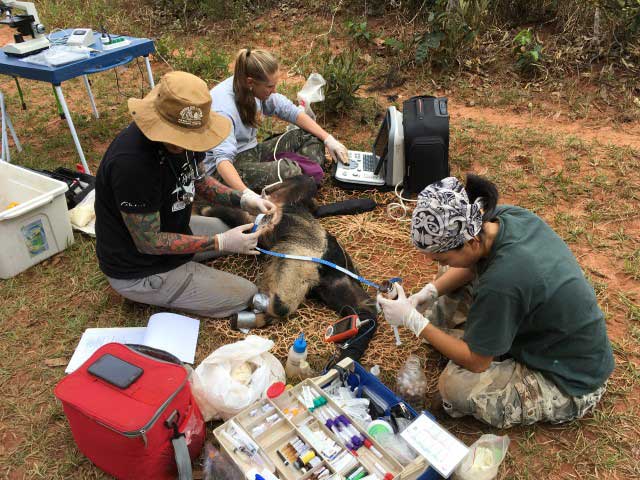
The road survey work in the Anteaters & Highways project is in its final year. After 27 months, we have reached a total of 71,500km of survey effort and we’ve recorded 8,411 road-kills. These include 1,363 six-banded armadillos, 622 nine-banded armadillos, 558 giant anteaters, 453 Southern tamanduas, 55 Southern naked-tailed armadillos and 6 giant armadillos. Tissue and blood samples were collected from 1058 road killed animals and 100 necropsies were performed, 58 of which were of giant anteaters.
We sadly lost another one of our collared giant anteaters to road kill. This time the GPS unit was really smashed and we couldn’t retrieve the data. We’ve now started to remove some radio collars from individuals. In April, 30 camera traps were also placed near and far from the BR 267 study area and we’ll be checking on these every month and re-positioning them in the study area.
Our educational materials, in particular 2000 copies of the book on giant anteaters, created through a partnership with the Greenville zoo and Reid Park Zoo, were printed and distributed in the areas where the animals will be released. It made sense for the Anteaters & Highways project to get involved, as the problem of orphan anteaters is an important animal welfare issue related to roadkill. We hope that we can bring back lessons learned from this experience back to Mato Grosso do Sul. This is a long term partnership and we’re very excited to see how it unfolds.
Rehabilitating orphaned giant anteaters
At the end of May, we’ll be starting a new partnership and a new project with the TamanduASAS Project, located in the State of Minas Gerais. This is our new initiative for this year which relates to the PTES-funded project Anteaters & Highways, but for which we need to start fundraising. The aim of this project is to rehabilitate giant anteaters whose mothers were killed, most often due to road kill. The TamanduASAS Project has been nursing and rehabilitating the anteaters and they have asked us to help them with the release and monitoring when they go back to the wild. The project coordinator shared bios of the three animals we’ll be releasing:
Dumbo arrived in the TamanduASAS Project on the 29th of May 2018, weighing only 1,240kg. Local residents found him alone vocalising very loudly in the urban area of Uberlandia (near the City’s water treatment plant). His first night alone without his mother was very difficult and due to stress he experienced severe hair loss which was only reverted through a lot patience, many bottles of milk and TLC.
Dumbo is a real scaredy cat! He is easily frightened but not at all aggressive. It took him a very long time to leave his blankets to explore his habitat. The smallest noise would make him run for cover. With time, Dumbo adapted well to life under human care and his weaning was easy with minimal weight loss. He is actually a real glutton! Sometimes he even lays down while eating to be closer to his food. Dumbo is the cleanest of the project. He loves to take baths in his pool at any time of the day. In fact the first time that he came into his new rehabilitation enclosure at the Retiro Águas Vivas ranch in March 2019 the first thing he did was go into one of the pools.
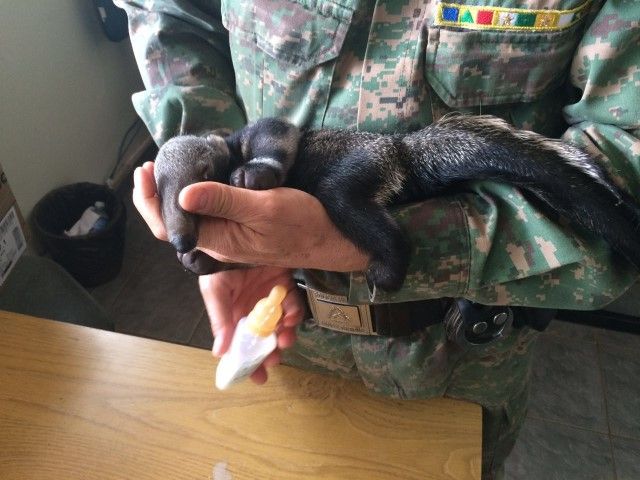
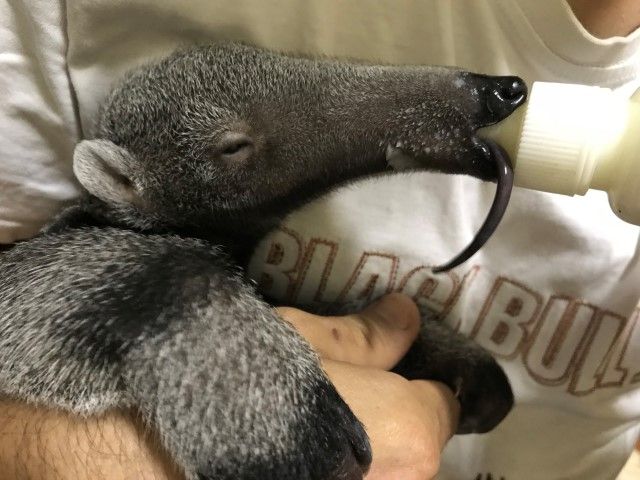
Chica Linda arrived to the TamanduASAS Project at 21:00 on the 9th of June 2018, after she was found alive hugging the dead body of her mother on a road in the Xapetuba region. She was dehydrated, full of ticks and weighed 1,245Kg. Chica took a long time to get used to using the bottle and required a lot of hard work from her caretakers. She is now well adapted and independent and maybe the less human imprinted giant anteater of the project.
She is curious and loves exploring. Since her early days she would leave her blankets to dig into the ground of her habitat. She was raised in the same rehabilitation enclosure as Dumbo, in the Retiro Águas Vivas Ranch. The project maintained a separation in the enclosure so that each animal could have their own space and pools.
Capitu was brought at the veterinary hospital of the federal university of Uberlandia in July 2017, where he was raised and weaned. He was supposed to be released without going through a rehabilitation centre in December 2018. However, he was too tame and used to people to be simply released and for this reason the environmental police asked the TamanduASAS to help. The TamanduASAS project took him to their rehabilitation enclosure in Tupaciguara. He now weighs 25kg and after one week learned to sleep in the middle of the vegetation. He has a big appetite and has now stopped seeking human interaction.
At the end of May we will be fitting the animals with collars and releasing them. We are conducting a brief observational study to observe the animals’ reaction to the collars. We will be training volunteers and members of the TamanduASAS Project on telemetry and monitoring methods.
I look forward to keeping you updated about this project throughout the year.
Arnaud
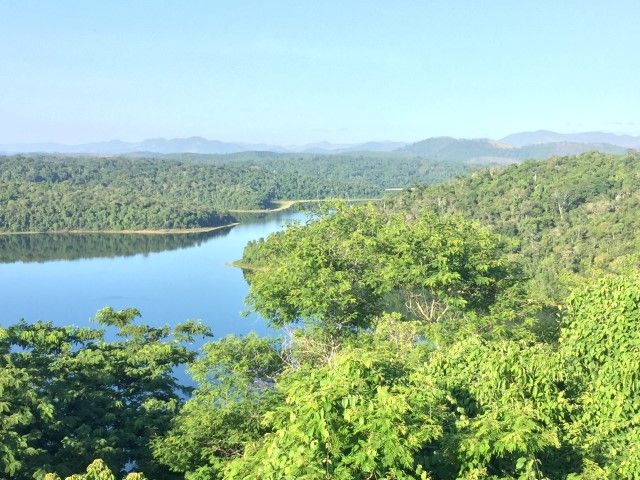
View of the State Park Rio Doce 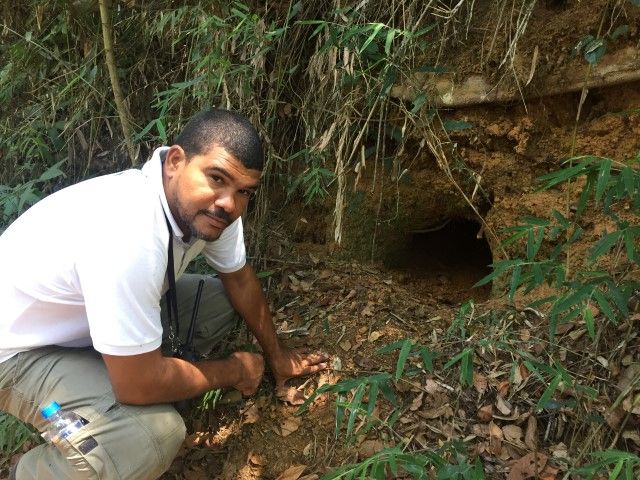
Forest guard in the State Park examining a burrow 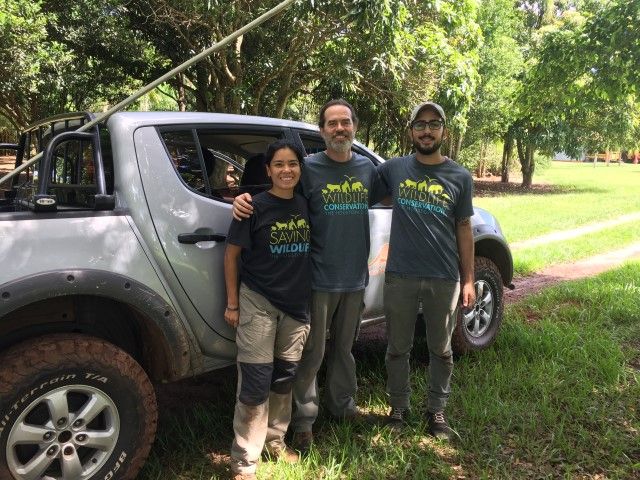
The ‘Anteaters & Highways’ team (Arnaud, project leader, pictured in the middle)
Arnaud Desbiez is our PTES project leader for the Anteaters & Highways Project in Brazil. Arnuad is a conservation biologist from France, who got his PhD in England from the Durrell Institute of Conservation and Ecology (DICE), University of Kent. He has been working and living in Mato Grosso do Sul, Brazil since 2002, specialising in natural resource management on topics ranging from hunting to soil management. Arnaud and his team work tirelessly to protect unique and charismatic species such as the giant anteater and giant armadillo. Arnaud and PTES would like to thank our supporters for helping us to fund this project to protect the future of giant anteaters.
